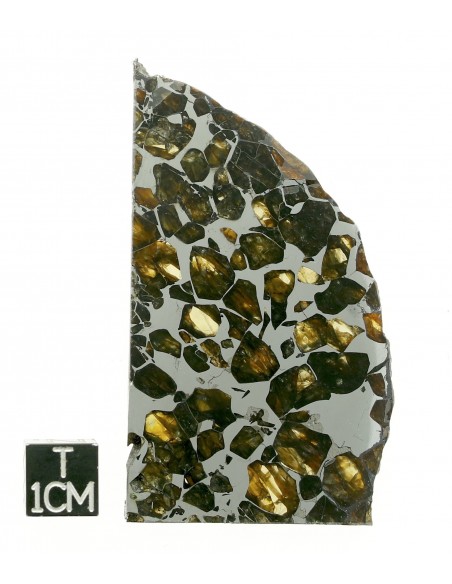SEYMCHAN Pallasite 19,70 g qualité AAA +
Tranche de la pallasite de Seymchan (qualité AAA +) d'un poids de 19,70 g pour environ 70 mm de hauteur large et 40 mm de large pour une épaisseur de 2 mm.
Un certificat d'authenticité signé, intégrant la photo de la pallasite, accompagne la météorite.
Tranche de la pallasite de Seymchan de qualité AAA+. Cette tranche révèle aussi de superbes cristaux d'olivine, la lumière passant à travers, dont certains sont de qualité gemme ce qui est extrêmement rare pour les pallasites.
Les pallasites sont considérées à juste titre comme les reines des météorites, les plus esthétiques, spécialement lorsqu'elles sont coupées en tranches fines et polies. Ce groupe de météorites consiste en un alliage de fer-nickel qui semble "baigner" des cristaux d'olivine de couleur jaune miel à vert olive.
Références du Meteoritcal Bulletin Database
(https://www.lpi.usra.edu/meteor/metbull.php?code=23510)
| Basic information | Name: Seymchan This is an OFFICIAL meteorite name. Abbreviation: There is no official abbreviation for this meteorite. Observed fall: No Year found: 1967 Country: Russia Mass: 323.3 kg |
||||||||||||||
| Classification history: |
This is 1 of 41 approved meteorites (plus 1 unapproved name) classified as Pallasite, PMG. [show all] Search for other: Main group pallasites, Metal-rich meteorites, and Pallasites |
||||||||||||||
| Comments: | Reclassified van Niekerk et al. (2007) Revised 26 May 2009: Revised pallasite classifications |
||||||||||||||
| Writeup | Writeup from MB 43: Warning: the following text was scanned and may contain character recognition errors. Refer to the original to be sure of accuracy. DISCOVERY OF SEYMCHAN IRON METEORITE, USSR Name: SEYMCHAN The place of fall or discovery: The meteorite has been found in a brook-bed flowing into the river of Hekandue, a left tributary of the river of Jasachnaja of the Magadan district, USSR. Date of fall or discovery: FOUND, June 1967. Class and type: IRON. Number of individual specimens: 2. Total weight: About 351 kg (about 300 kg and 51 kg). Circumstances of the fall or discovery: The larger specimen has been found by the geologist F. A. Mednikov during a geological survey. The meteorite hardly seen was lying among the stones of the brook-ebd. The smaller specimen was found at a distance of 20 m from the first one by I. H. Markov with a mine detector in october 1967. The main mass was turned to the Academy of Sciences of the USSR. Source: Report of geologist F. A. Mednikov (Magadan, USSR) in a letter, VIII 15, 1967 and of V. 1. Zvetkov (Moscow, USSR) in a letter X 17, 1967. |
- Dr Luc Labenne
Membre de la Meteoritical Society






